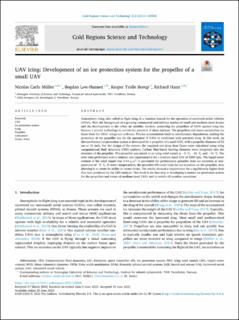| dc.contributor.author | Müller, Nicolas Carlo | |
| dc.contributor.author | Løw-Hansen, Bogdan | |
| dc.contributor.author | Borup, Kasper Trolle | |
| dc.contributor.author | Hann, Richard | |
| dc.date.accessioned | 2024-02-26T08:44:24Z | |
| dc.date.available | 2024-02-26T08:44:24Z | |
| dc.date.created | 2023-07-24T12:09:12Z | |
| dc.date.issued | 2023 | |
| dc.identifier.citation | Cold Regions Science and Technology Volume 213, September 2023, 103938 | en_US |
| dc.identifier.issn | 0165-232X | |
| dc.identifier.uri | https://hdl.handle.net/11250/3119808 | |
| dc.description.abstract | Atmospheric icing, also called in-flight icing, is a common hazard for the operation of uncrewed aerial vehicles (UAVs). With the background of a growing commercial and military market of small and medium-sized drones and the developments in the urban air mobility markets, protecting the propellers of UAVs against icing has become a pivotal technology to unlock the potential of these markets. The propellers and rotors accumulate ice faster than the UAVs’ wings and airframe. This ice accumulation leads to aerodynamic degradation, making the protection of the propeller key for the operation of UAVs in conditions with potential icing. In this work, an electro-thermal ice protection system is developed for a propeller of a small UAV, with a propeller diameter of 53 cm or 21 inch. For the design of the system, the required anti-icing heat fluxes were calculated using icing computational fluid dynamics (CFD) analysis. Carbon fibre-based heating elements were integrated into the structure of the propeller. This propeller was tested in an icing wind tunnel at −5 °C, −10 °C, and −15 °C. The tests were performed with a rotation rate representative for a medium-sized UAV of 4200 rpm. The liquid water content of the wind tunnel was 0.44 g/m3. It prevented the performance penalties from ice accretion at temperatures of −5 °C. At lower temperatures, the propeller IPS could limit the ice accretion on the propeller, thus allowing it to retain its ability to create thrust. The results showed a requirement for a significantly higher heat flux than predicted by the CFD analysis. This work is the first step in developing a mature ice protection system for the propellers and rotors of medium-sized UAVs and to enable all-weather operations. | en_US |
| dc.language.iso | eng | en_US |
| dc.publisher | Elsevier | en_US |
| dc.rights | Navngivelse 4.0 Internasjonal | * |
| dc.rights.uri | http://creativecommons.org/licenses/by/4.0/deed.no | * |
| dc.title | UAV icing: Development of an ice protection system for the propeller of a small UAV | en_US |
| dc.title.alternative | UAV icing: Development of an ice protection system for the propeller of a small UAV | en_US |
| dc.type | Journal article | en_US |
| dc.type | Peer reviewed | en_US |
| dc.description.version | publishedVersion | en_US |
| dc.source.volume | 213 | en_US |
| dc.source.journal | Cold Regions Science and Technology | en_US |
| dc.identifier.doi | 10.1016/j.coldregions.2023.103938 | |
| dc.identifier.cristin | 2163213 | |
| dc.relation.project | Norges forskningsråd: 321667 | en_US |
| dc.relation.project | Norges forskningsråd: 316425 | en_US |
| cristin.ispublished | true | |
| cristin.fulltext | original | |
| cristin.fulltext | original | |
| cristin.qualitycode | 2 | |

